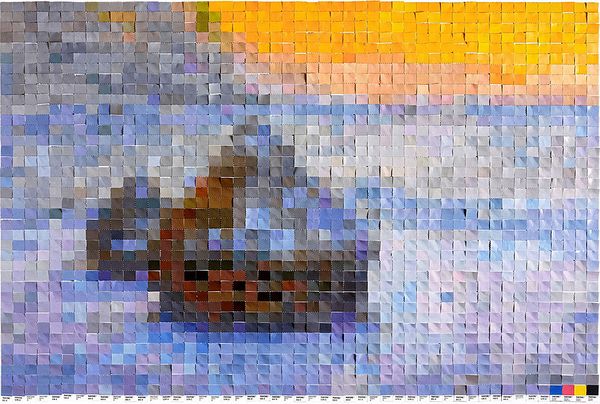Vik Muniz, Haystacks #5 after Claude Monet from Pictures of Color, 2001. Photographs New York.
Vik Muniz: The Homage
“Now that photography is a digital medium, the ghost of painting is coming to haunt it,” notes Vik Muniz. “[…] Photography no longer retains a sense of truth. I think that's great, because it frees photography from factuality, the same way photography freed painting from factuality in the mid-nineteenth century.” Manipulating representation from the original to the “after” work, Muniz leans more heavily on the analogue end of reproduction by physically assembling a simulacrum of his source material, then photographing the result and often destroying his original so that the only remaining work is the photograph. Haystacks #5 is a well-rounded example of not only this approach, but also its wider implications as laid out by Muniz above. Made up of Pantone color swatches, the artist’s homage to Monet’s canonical work operates as meta-analysis and fun in equal measure. The deliberate use of Pantone swatches, which are individually coded so that any artist can search and obtain the exact shade used by any other, recalls the exactitude of pixels, which are in turn a digital update of the elements which captured essence rather than detail in Impressionism. From our lofty 4K HD perches of 2022, however, we can easily forget a secondary aspect of Muniz’s work, one which emerges as a result of the pace of the digital medium. In 2001, the average resolution of a digital interface was 600x800. To stretch an image to the usually grand scales of Muniz’s work would be to lose pixel-perfect precision, and thus by dint of limits of the world of Windows 2000, the pixel and Impressionist brushstroke become one, rendering Muniz’s hauntology prescient. What is new and what is old collide; time is out thrillingly of joint.
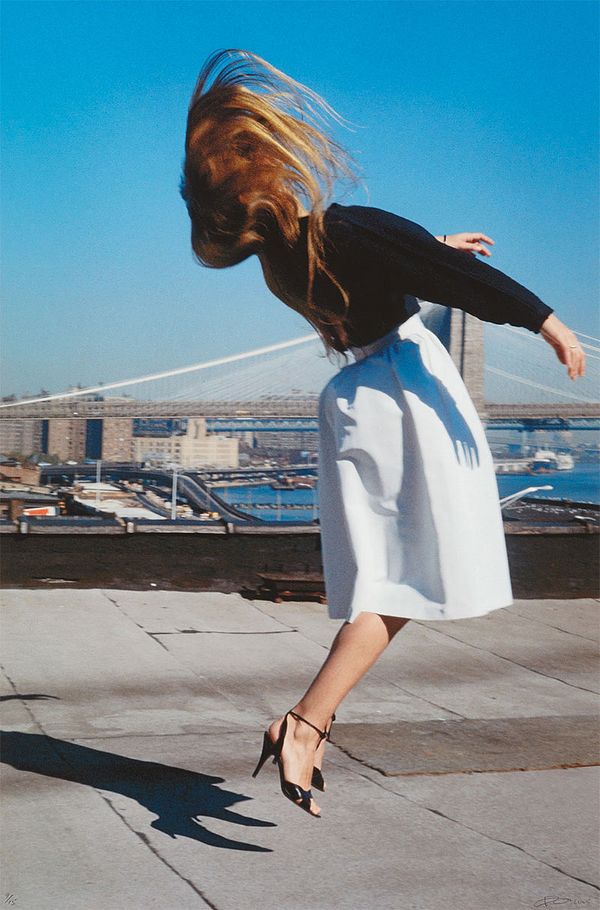
Robert Longo, Untitled Pl. 13 from Men in the Cities, 2005. Photographs New York.
Robert Longo: The Body in Motion
The ballistics experts might say our subject is jumping; the point of artistic ambiguity is to consider that she might instead be falling. Or dodging, or writhing, or any number of contorted movements captured by Robert Longo’s Men in the Cities series, as his subjects avoided hurled items, felt the pull of ropes, or were startled by unexpected noises to mimic the recoil of gangster movie shootouts. We are immediately drawn to the tangle of hair and the crisp poplin skirt, as we would with any photorealistic work, but it is Longo’s mixture of theatricality and realism that gives the image the expressive feel of a painting. The painted bird is never obligated to land, but we are taught by experience that gravity applies to photographs, so Longo’s series acts more like freeze frame shots, caught between action and reaction, unable to reconcile cause and effect, and therefore perpetually stuck in the act of motion.
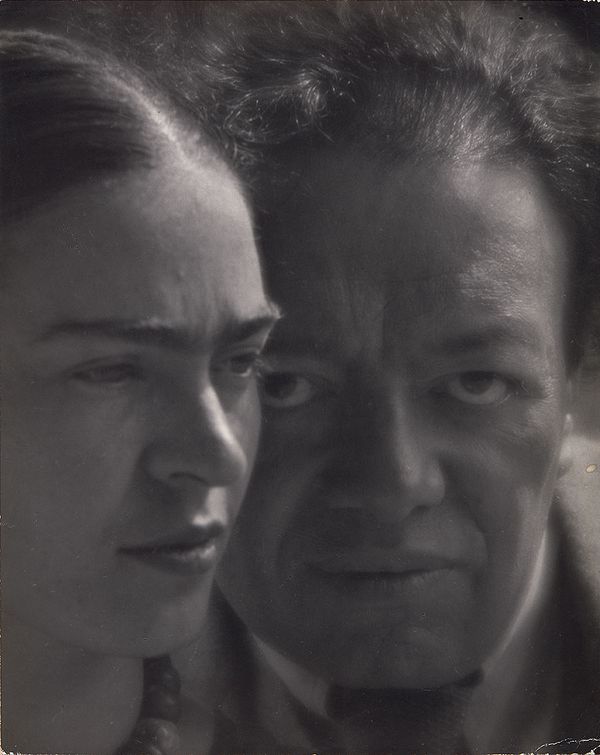
Martin Munkácsi, Frida Kahlo and Diego Rivera, 1934. Photographs New York.
Martin Munkácsi: The Portrait
The immediate difference between the painted portrait and its photographic double is just that: immediacy. Unbound by the temporal need to pose, the sitter can be captured and presented across any number of moments in a session, rather than a single or composite image. Nonetheless the imperative to pose stays and unites the two mediums – instantaneous or labored, the final portrait is permanent. These blurred distinctions between time, space, subject, and representation offer a series of counterpoints in Martin Munkácsi’s portrait of Frida Kahlo and Diego Rivera. The Surrealist and the muralist, the steely gaze and the wandering glance, foreground lightness and background severity all meeting somewhere in the middle of the image, dissolving into a touch forced by the camera’s perspective yet not actually there. In order to fully capture the painters, Munkácsi executes his portrait with painterly technique.
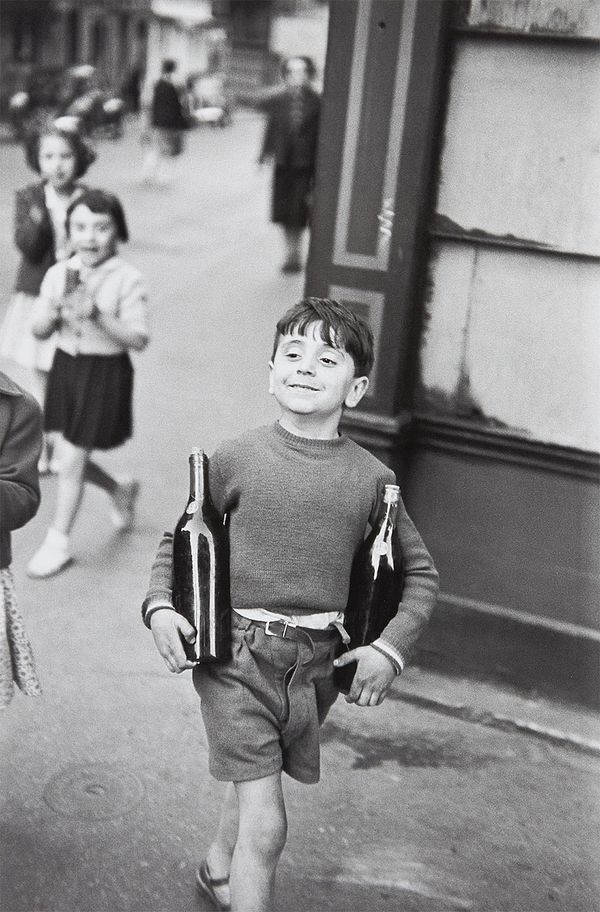
Henri Cartier-Bresson, Rue Mouffetard, Paris, 1952. Photographs New York.
Henri Cartier-Bresson: The Street Scene
Henri Cartier-Bresson did not plan or arrange his photographs. His practice was to release the shutter of his hand-held Leica when his instincts told him the scene before him was in perfect balance – a concept he dubbed "the decisive moment," and one which captured flashes of beauty among the ordinary goings-on of daily life. The Parisian street scene was a staple of late 19th and early 20th century French painting, typified by the likes of Edouard Henri Leon Cortès, Eugène Galien-Laloue, and Antoine Blanchard, artists whose studied streetscapes often seemed to be après la pluie, or just under enough weather to obscure faces and shuffle the human element into the middle distance for the sake of the overall scene. In this sense, Cartier-Bresson inverts the tradition set by these painters and modernizes the street scene with its focus on character over landscape and presence over staging. His Rue Mouffetard is bustling with marketgoers, just as it was in the time of Galien-Laloue, however Cartier-Bresson finds in it the spontaneous subject of a boy confidently carrying out a shop order and striding into his day. We can name him if we want to; we can recognize him. And look further: behind him, clouded by the limit of the lens’ grasp, the woman in the middle distance, as if plucked from one of Cortès’ paintings to remind us of the way things were before the camera brought us into focus.
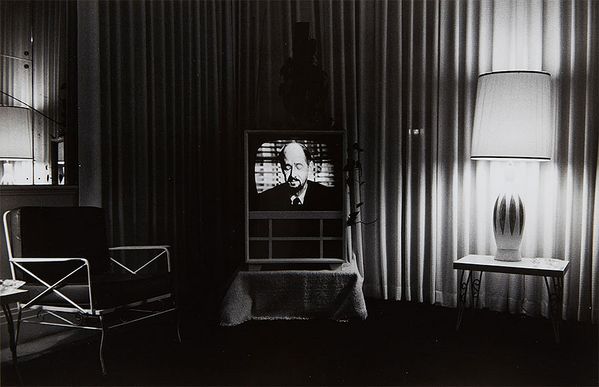
Lee Friedlander, Florida, 1963. Photographs New York.
Lee Friedlander: The Allusion
Contrast Cartier-Bresson to Lee Friedlander, whose “social landscape” approach offers, as Friedlander himself said, “a mysterious intersection of chance and attention that goes well beyond the existential surrealism of the ‘decisive moment’.” At the heart of Friedlander’s cutting, witty photography is an irony of allusion. Smithed in the vast cultural absurdity of midcentury America, where by 1963 televisions were a staple of hotel rooms across the country, Friedlander’s lens in his Little Screens collection replaces presence with ghosts, favoring the itinerant nature of the traveler to the local guide. And what better way to capture the essence than to bask in the valve-amplified glow of television? Friedlander stifles the world contained within the screen, with all of its sound and news of the outside by silencing the noise and pausing the moment. Exactly 70 years earlier, in 1893 (and well before the invention of the mute button), Edvard Munch’s The Scream alluded to the coming century and all of its din and silence and horror, allowing Friedlander, smack in the middle of that century, to mute the sound once again, only now by choice. It is a vague evening in 1963, which means the man on the screen could be be reading promo for The Birds or announcing that something terrible has happened in Dallas. 70 years on from Florida, in 2033, experts on screens say we will be living full-time in the metaverse, on our own little screens, situating Friedlander firmly into the artistic tradition of soothsaying.
Discover More from Photographs New York >
Recommended Reading
Promethean Figures: Peter Beard and Francis Bacon, 1976 >
A Mapping of the Self: Photographs from the Collection of Peter McLeavey >
